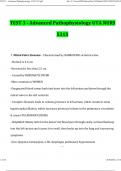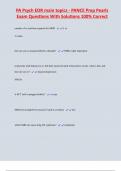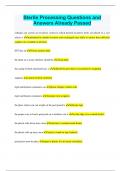TEST 3 - Advanced Pathophysiology UTA 5315.pdf file:///C:/Users/HP/Desktop/New%20folder%20(2)/TEST%203%2
TEST 3 - Advanced Pathophysiology UTA NURS
5315
1. Mitral Valve Stenosis: - Characterized by NARROWING of mitral valve
- Normal is 4-6 cm
-Narrowed is less than 2.5 cm
- Caused by RHEUMATIC FEVER
-More common in WOMEN
-Oxygenated blood comes back into heart into the left atrium and down through the
mitral valve to the left ventricle
- Complex: Stenosis leads to volume/pressure in left atrium, which results in atrial
hypertrophy/dilation, which increases pressure/volume in the pulmonary circulation
& causes PULMONARY EDEMA
- Simplified: Skinny mitral valve doesn't let blood pass through easily, so blood backsup
into the left atrium and causes it to swell, then backs up into the lung and causesresp.
symptoms
-S/sx: dyspnea, hemoptysis, a-fib, dysphagia, pulmonary hypertension
1 of 68 10/30/2024, 10:10
,TEST 3 - Advanced Pathophysiology UTA 5315.pdf file:///C:/Users/HP/Desktop/New%20folder%20(2)/TEST%203%2
2. Mitral Valve Regurgitation: -Characterized by INCOMPLETE CLOSURE of mi-tral
valve
-Caused by MITRAL VALVE PROLAPSE (flaps don't close together properly, leavingvalve
ajar); more common in WOMEN; STICKING CHEST PAIN
-Blood in left ventricle backs up to left ventricle during systole (mitral valve should
be closed during systole/contraction of heart)
-Leads to atrial dilation/hypertrophy, increased pulmonary vascular pressure/vol-
ume, PULMONARY EDEMA
-S/sx: Dyspnea, rales, pansystolic murmur, S3 & S4 heart sounds
3. Aortic Valve Stenosis: -Most common valvular disease
-Most common causes are aortic valve CALCIFICATION (stiffening) in people over60;
congenital aortic valve stenosis in people less than 30
-Normal valve 3 cm; symptoms seen when valve less than 1 cm; severe when valveis
less than 0.5 cm
-Narrowed valve prevents outflow from left ventricle to aorta.This backs up blood to
the left atrium and ultimately floods the lung causing PULMONARY EDEMA
S/Sx: Pulmonary hypertension/edema, poor outflow of aorta to body (aorta sends
out oxygenated blood to body), causing fainting or chest pain
Simplified: Aorta is stiff and can't send out oxygenated blood properly to the body,
2 of 68 10/30/2024, 10:10
,TEST 3 - Advanced Pathophysiology UTA 5315.pdf file:///C:/Users/HP/Desktop/New%20folder%20(2)/TEST%203%2
depriving tissues of oxygen. Blood gets backed up into lungs, causing pulmonary
edema.
4. Aortic Valve Regurgitation: -Valve is TOO WIDE or TOO NARROW, blood
doesn't pass through effectively, causing back flow of blood into the left ventricle
-Marked by EARLY DIASTOLIC MURMUR (on systole, heart contracts and pushes
3 of 68 10/30/2024, 10:10
,TEST 3 - Advanced Pathophysiology UTA 5315.pdf file:///C:/Users/HP/Desktop/New%20folder%20(2)/TEST%203%2
blood up the aorta, but on diastole, heart relaxes and ineffective aortic valve is notable
to hold blood up in aorta, so blood falls and makes a swish sound, which is themurmur)
-Most commonly caused by AORTIC ROOT DILATION(starting point of aorta is too
wide)
-Other causes: infective endocarditis, rheumatic fever, aortitis from syphilis, coarcta-
tion (congenital narrowing of aorta), aortic dissection (tear), ankylosing spondylitis
(inflammatory arthritis)
-Acute: increases left ventricular end-diastolic pressure (LVEDP) (increased blood
back down in the left ventricle increases pressure), decreased stroke volume (not
much blood is being pushed from left ventricle because blood's backed up and over-
whelming left ventricle), normal or decreased pulse pressure, decreased cardiac
output (aorta is not effectively pumping blood from heart)
Chronic: Body adjusts; LVEDP normalizes, systolic bp increases (compensation:
harder contraction to push blood out of aorta before it falls back down to left
ventricle), diastolic bp decreases (compensation: decreased relaxation of heart to
stop blood from seeping back out of aorta), cardiac output is normal, pulse
pressure is increase.Blood ultimately is backed up into the left atrium and pulmonary
4 of 68 10/30/2024, 10:10






